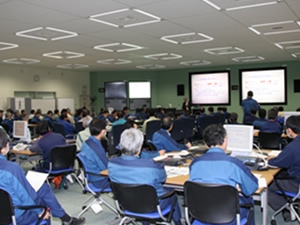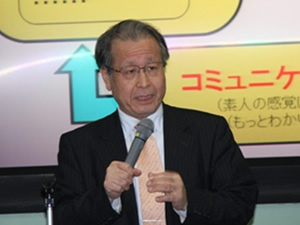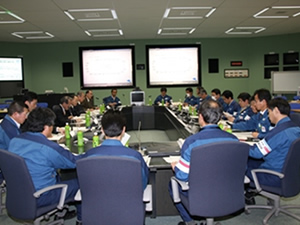|
|
 |
|
The 112th Safety Caravan was held at the Tokyo Electric Power Company's (TEPCO) Fukushima Daiichi Nuclear Power Station in Futaba Town and Okuma Town in the Futaba District of Fukushima Prefecture on March 5, 2009. |
| Safety Presentation |

|
|
During the Safety Presentation
|
The Safety Presentation was attended by 120 Fukushima Daiichi Nuclear Power Station employees and employees of contracting companies.
Akio Komori, Site Superintendent of TEPCO's Fukushima Daiichi Nuclear Power Station, opened the session with the following address.
"I believe that it is important for us to assume a stance in our unrelenting effort regarding safety culture and nuclear power safety in which we continually check and reflect on our own actions to improve. In that regard, we are functioning as operators when we incorporate outside opinions in connection with our engagement in a lively internal debate as we use our own awareness to drive us to improve safety. That is to say, I feel that both a boost from within and comments from without are what enable our activities to achieve the momentum that elevates our work.
"Additionally, there are many different types of external efforts, such as those invested with a certain level of objectivity and disinterest, which include peer reviews, and those mandated by law, which include inspections by regulators. However, the nature of the Safety Caravan perhaps has its aim in a slightly more flexible step into our activities as operators by exchanging opinions to improve the safety culture.
"In that sense, in order that we may share our awareness, not only are the employees of this station here today, but contractors whom we work alongside with are also participating. I feel this good opportunity will allow us to exchange opinions in a format transcending our roles. I hope that you will not hesitate to pose questions and voice your observations."
Following the opening address, Dr. Masaharu Kitamura, professor emeritus of Tohoku University and visiting professor at the Tohoku University New Industry Creation Hatchery Center, gave a presentation entitled “Organizational Individuality and Safety Culture.”
The main points of Dr. Kitamura's beneficial presentation are summarized below.
|

|
|
Dr. Masaharu Kitamura, professor
emeritus of Tohoku University
and visiting professor at the Tohoku University
New Industry Creation Hatchery Center
|
In the nuclear power industry, a long time has passed since the importance of having a safety culture was pointed out. The IAEA definition of safety culture is widely known in the world of nuclear power, and many people engaged in nuclear power operations have seen and heard it many times. Organizational approaches aimed at fostering a safety culture also ought to be actively advanced at each business establishment, but when furthering such activities, attention is required to cultural diversity as well as intercultural factors held by the organization and individuals.
Even in industries other than nuclear power such as nanotechnology and biotechnology, there presently is a "discord" being seen between technology and society. So, there are concerns that this will result in the technology risks not well understood by society becoming even greater. Thus, it is important that there be constant external communication. One regulatory administrative approach is the policy decided on in regard to "Guidelines for Assessing Efforts to Prevent Deterioration of the Organizational Climate and Safety Culture of a Business." Within this framework, the concept of safety culture is definitely not pedantic, but has retained flexibility.
In a model put forward by Professor Yoshida at Kumamoto University in regard to organizational climate and safety culture, a long period of time is spent following the course of "climate → culture → standards → behavior/conduct → standards → culture → climate," during which interaction occurs, transforming the climate and culture. To the extent that a basic philosophy which values safety is secured, the mode in which a safety culture is embodied may range widely and does not present a problem.
To put it in broad terms, safety culture is communication. However, there are inherent difficulties in communication, so unless circumstances are configured and true motives confirmed, effective communication will not be established.
Intercultural communication is premised on the importance of recognizing differences and being aware of one's self. In addition, techniques for effective intercultural communication include taking a stance which emphasizes empathy, or identifying with others, rather than one which stresses sympathy or compassion, as well as introducing the concept of assertiveness, which is also desirable so that the dialogue does not end up being self-flattering. In addition, in order to secure understanding and agreement in communication with another person whose perception is considerably different from one's own, a person must not adhere only to factual explanations, but also attempt a story-like description, which will make it possible to dispel antagonism.
Some comments from the audience survey taken after the presentation:
- Thank you for the detailed and easy-to-understand guidance on tricks to communicating inside and outside organizations. I will work on communicating with empathy. Thank you.
- Once again, I realized how important communication is. I thought that I would like to communicate while bearing in mind the circumstances configured, sharing with the other person, conducting an assertive dialogue, and other such ideas.
- At our company also, we are providing training and other education, which encompasses contractor personnel, to improve communication as a means of stimulating a sense of unity in the workplace and enhancing the company climate. The content of the session was meaningful in that it renewed my appreciation that another perspective is needed to view the necessity of activities which I myself undertake, and that there is no one scheme which is correct, but continuing such activities is important.
- I have often felt the difficulty of intercultural communication. The environment in which we are all raised is different. So, the ideas of communicating with empathy, furthering communication by deepening understanding, active listening, and an open-end and so on were very useful.
- I was able to get a good understanding of the professor's assertion that giving consideration to intercultural communication is important for promoting a safety culture. I understood that it is effective to have not only the facts, but also a story-line.
|
Safety information exchange session |

|
|
During the Safety information exchange session
|
At the Safety Information Exchange Session, regarding "Activities Affecting the Promotion of a Safety Culture," the FY2008 assessment of Fukushima Daiichi Nuclear Power Station and the plan for FY2009 were presented, and then opinions were exchanged.
|
|
|







